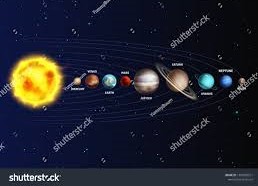what is solar system

The Solar System is a gravitationally bound system consisting of the Sun and all the celestial objects that orbit it. It is part of the Milky Way galaxy, located in the Orion Arm. The Solar System formed approximately 4.6 billion years ago from a dense cloud of interstellar gas and dust, likely triggered by a shockwave from a nearby supernov
Components
The Solar System comprises various celestial bodies that can be classified into different categories based on their characteristics and location:
- The Sun: A G-type main-sequence star at the center of the Solar System, containing over 99% of its total mass. The Sun’s gravity holds the Solar System together and its energy supports almost all life on Earth.
- Planets: Eight planets orbit the Sun in elliptical paths. These include:
- Inner, rocky planets (terrestrial planets): Mercury, Venus, Earth, and Mars. These are denser and primarily composed of solid rock and metal.
- Outer, giant planets (Jovian planets): Jupiter, Saturn, Uranus, and Neptune. These are further divided into gas giants (Jupiter and Saturn) and ice giants (Uranus and Neptune) based on their composition. They lack a solid surface.
- Dwarf Planets: Objects, like Pluto, that are spherical and orbit the Sun, but haven’t “cleared their orbital neighborhood” of other bodies.
- Moons: Natural satellites orbiting planets or dwarf planets. Earth’s Moon is a well-known example. There are hundreds of moons in the Solar System, including active ones like Io (around Jupiter) and potentially habitable ones with subsurface oceans, like Europa and Enceladus.
- Asteroids: Small, rocky objects, mostly found in the asteroid belt between Mars and Jupiter.
- Comets: Icy bodies that develop a tail as they approach the Sun, typically originating from the Kuiper belt or Oort cloud.
Structure
The Solar System has a structured arrangement:
- Inner Solar System: Consists of the terrestrial planets and the asteroid belt. Objects here are closer to the Sun and primarily composed of silicates and metals.
- Outer Solar System: Includes the gas and ice giants and the Kuiper belt, which is home to dwarf planets and other icy bodies beyond Neptune.
- Oort Cloud: A theoretical spherical shell of icy objects at the outermost edge of the Solar System, thought to be the source of long-period comets.
The vast distances between planets are often measured in Astronomical Units (AU), where 1 AU is the average distance between Earth and the Sun. Despite the immense size of the Solar System, it is still just a small part of the vast Milky Way galaxy.
Benefit of solar system

Solar power systems, particularly rooftop solar installations, offer numerous benefits for both homeowners and businesses looking to reduce their energy costs and carbon footprint.
Here are the key advantages of installing a solar power system:
1. Environmental benefits
- Reduces Air Pollution and Greenhouse Gas Emissions: Solar energy generation is significantly cleaner than relying on fossil fuels, reducing the emission of harmful pollutants and greenhouse gases that contribute to climate change and impact public health.
- Water Conservation: Unlike traditional power plants that use large amounts of water for cooling, solar energy systems require minimal water for operation, especially according to Solnce Energy and Novergy Solar.
- Reduced Dependence on Non-renewable Resources: Solar energy harnesses sunlight, a renewable and abundant resource, lessening reliance on finite fossil fuels like coal, oil, and natural gas.
2. Financial benefits
- Lower Electricity Bills and Long-Term Savings: Generating your own electricity through solar panels significantly reduces or even eliminates your reliance on the grid, leading to lower monthly utility bills and long-term savings on energy expenses.
- Government Incentives and Subsidies: Many governments offer incentives, such as tax credits, rebates, and subsidies, to encourage solar energy adoption, helping to offset the initial installation costs.
- Increased Property Value: Homes with solar panels are considered upgrades, potentially increasing the property’s market value and making it more attractive to potential buyers.
- Stable and Predictable Energy Costs: Solar power provides a fixed energy rate for decades, shielding you from rising electricity tariffs and potential fluctuations in energy prices.
3. Energy independence and security
- Reduced Reliance on the Grid: Generating your own power lessens your dependence on the conventional power grid, providing a reliable and stable energy source, particularly during power outages.
- Backup Power Source: Solar power, especially when combined with battery storage systems, can provide a reliable backup power source during grid failures or outages.
- Energy Cost Hedge: Solar energy helps hedge against rising electricity tariffs and unpredictable price increases, securing your energy costs for the long term.
4. Other benefits
- Low Maintenance: Solar power systems require minimal maintenance, typically involving occasional cleaning and routine checks.
- Long Lifespan: Solar panels are designed to be durable and typically have a lifespan of 25-30 years, providing decades of energy production.
- Technological Advancements: Ongoing research and development in solar technology continue to improve panel efficiency, storage solutions, and reduce costs, making solar power an even more viable and attractive energy source in the future. In Conclusion: Solar power systems offer a wide array of advantages, making them a strategic and environmentally responsible choice for individuals and businesses looking to secure their energy future while contributing to a sustainable
<iframe width=”560″ height=”315″ src=”https://www.youtube.com/embed/-GfNEDs3ERw?si=iHptsf_1zzbV7PPW” title=”YouTube video player” frameborder=”0″ allow=”accelerometer; autoplay; clipboard-write; encrypted-media; gyroscope; picture-in-picture; web-share” referrerpolicy=”strict-origin-when-cross-origin” allowfullscreen></iframe>